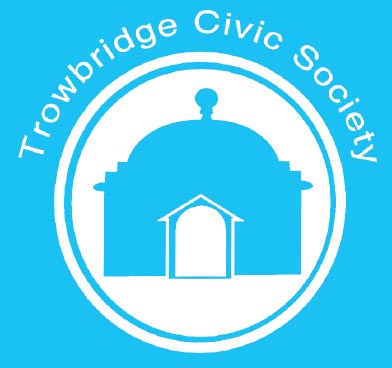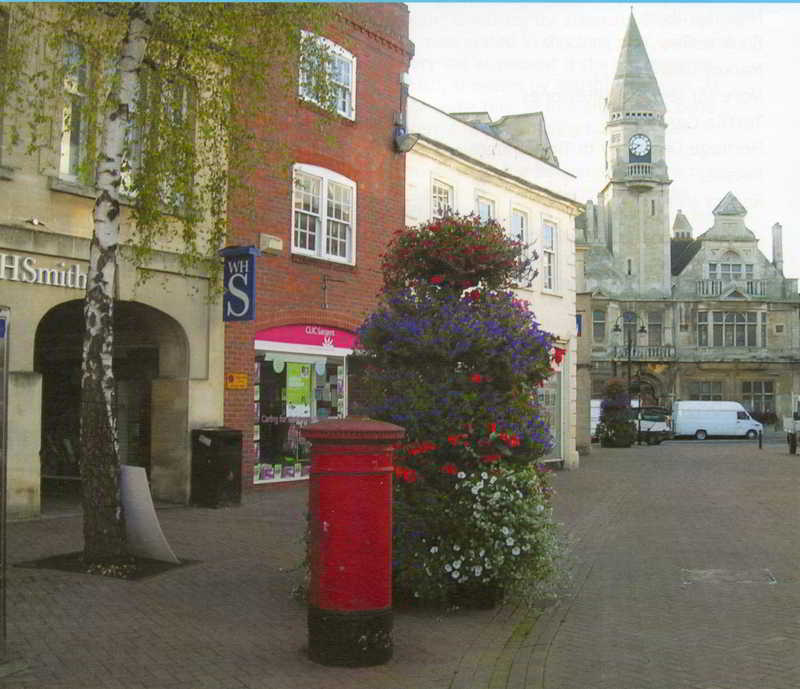| ||||||||||||||||||||||||||
Contents
Click on the item to go to the article. |
Editorial CommentLosing some of our churches seems inevitable but at least the buildings mostly remain – and we eagerly wait to see what becomes of the Baptist Emmanuel Church in Church Street, Trowbridge. The demolition of Blue Hills in Hilperton (see Planning Matters) will mean losing forever a beautiful house (green glazed tiles, tiny window panes etc, so typical of the late 192Os/1930s Art Deco style) which is almost certainly the only example of its type in the locality. Go and find it, savour it and take a photograph for posterity. |
Forthcoming Events
| 2009 | ||
| Tuesday 20th October 19:30 |
PUBLIC LECTURE – Talk on the origin of Wiltshire Villages by Ken Rogers | Manvers Hall, United Church, Church Street, Trowbridge. |
| Tuesday 17th November 19:30 |
TALK – “GOING TO BLAZES” an insight into the more amusing side of life in the fire and rescue service by Mr. John Craig QFSM | Manvers Hall, United Church, Church Street, Trowbridge. |
| 2010 | ||
| Tuesday 19th January 19:30 |
New Year Social and Quiz – Please bring a plate of food – Drink provided. | HADEN ROOM, United Church, Church Street, Trowbridge. |
| Tuesday 16th March 19:15 |
Annual General Meeting followed by a talk to be announced |
Manvers Hall, United Church, Church Street, Trowbridge. |
From the Chairman
Several buildings in the town are to undergo a change of use. Unfortunately, the Town Hall is not yet on the list but Emmanuel Baptist Chapel is, together with its associated buildings, all of which have been sold. The purchaser, Mr Shanley, has a very good record for restoration of listed properties – for example, St James Hall, DK Estate Agents (the 15th century hall house) and the former Co–op in Church Street. He is already in the process of having the Baptist Chapel re–roofed in state. Another church which may well see a change of use is Holy Trinity. The congregation is joining with Wesley Road Methodists and the Church of England is looking for alternative use for the building which, amazingly, is being completely redecorated in shocking pink, pink and more pink! Another building which is looking very sad at present is the old Margaret Stancomb Infants' School. This, like the Town Hall, is owned by Wiltshire Council. At present the school is boarded up and it could be some time before anything is done with it. I know there has been considerable interest in the building but Wiltshire Council appear to be unwilling to commit to any change of use.
Although the College did not get its funding to move to the Bowyer site, the project is not completely dead but it may take a few years before funds become available.
On June 23rd this year English Heritage launched a campaign to save neighbourhood heritage and the following points are taken from their press release.
“There is much concern over the state of many conservation areas as more than 1 in 11 such areas in the South West are at risk of neglect, decay or unsympathetic change and many more are giving cause for concern. The aim of the English Heritage campaign is to get residents, local groups and councils working together to improve these special places before it is too late. Of the 1500 conservation areas in the region, 107 were found to be at risk. Nationally, English Heritage's survey revealed the top threats to be:
- plastic windows and doors (83% of conservation areas affected)
- poorly maintained roads and pavements (60%)
- street clutter (45%)
- loss of front garden walls, fences and hedges (43%)
- unsightly satellite dishes (38%)
- the effects of traffic calming or traffic management (36%)
- alterations to the fronts, roofs and chimneys of buildings (34%)
- unsympathetic extensions (31%)
- impact of advertisements (23%)
- neglected green spaces (18%).”
Andrew Vines, English Heritage Regional Director for the South West, said: “The South West's historic environment is extraordinarily rich and diverse. When it is threatened by unsympathetic change or neglect, the social, environmental and economic potential of the region is endangered. Reversing neglect and finding sympathetic new uses is in all our interests … We now know the condition of more than 40% of the region's conservation areas. We all live in, visit or work in a conservation area on a regular basis and looking after our conservation areas is a responsibility we all share.” A sentiment with which I am sure we will all agree. What was interesting is that a poll of estate agents by English Heritage revealed a solid economic case for caring for the region's conservation areas. Over 82% said that original features add value to a property, 75% reported that being in a well–kept conservation area enhances house prices. I don't know whether Wiltshire Council responded to the campaign or whether any of our Conservation Areas are in the ‘at risk’ category but I fear they could well be.
Planning Matters
Warminster Civic Trust has a strap line, ‘Celebrating the Past, Managing the Present, Inspiring the Future’. This reflects exactly what we try to do by closely monitoring planning applications and decisions.
The former Black Swan Inn on the corner of Adcroft Street received approval for conversion so we must make sure the past is celebrated by the restoration of the hanging sign and the word STABLING on the store lintel, exactly as in photographs, as promised by the owners. The application to convert the Auto Spares shop on the corner of Gloucester Road and Newtown to residential use, states that the exterior will be unchanged, thus the original use by the Co–op will still be celebrated. The redecoration and improved lighting recently approved for the Cemetery Chapel should help to make it a nicer place for families saying a final farewell to their loved ones.
Two buildings in need of careful management in the present are The Rose and Crown and The Stallards, both in Stallard Street. We are happy about the pLans for the latter to enable food to be served, necessary these days for an inn to be a viable business. We are not happy about the plans for the Rose and Crown. We have no objection to exposing the brick and ashlar facade. The listed building description states a painted facade, but we do not believe it would have been like this in the 19th century. We would prefer that the garage block be retained and refurbished to form the bedroom block rather than demolished and rebuilt. The windows are not in keeping with the main building and with the loss of 2 garages there will be no alternative parking for the landlord or guests.
Subway are taking over the Fore Street premises that were Berkleys Coffee Shop and have approval for signs to this effect. They have also applied to extend their opening hours to allow overnight baking. We have asked that conditions be applied so that local residents are not disturbed at night by smells or noise. Outline planning permission has been granted for the demolition of Blue Hills in Devizes Road, Hilperton. We must look carefully when the full application is submitted for the replacement homes, although it is difficult to see how they can be as inspiring as Blue Hills, which is so typical of its era.
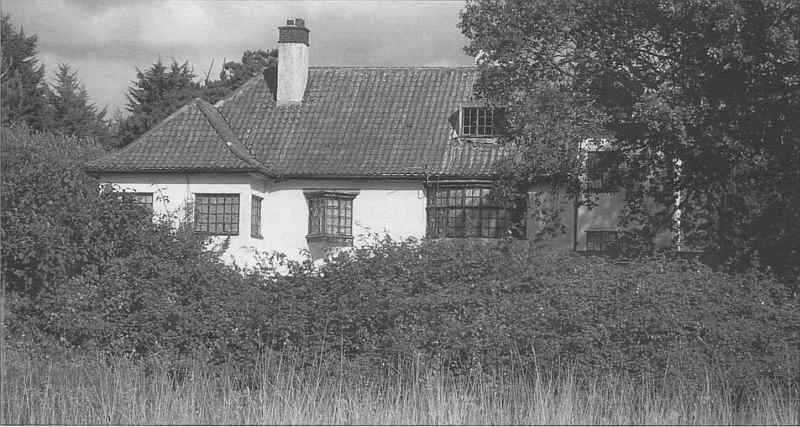
Update on Development Sites
First the bad news – Modus went into administration and therefore the Waterside Project is delayed by several years as a new developer will have to be chosen. The other bad news is that the relocation of Wiltshire College to the Bowyers Factory Site is also delayed. This is due to the Learning and Skills Council having grossly over committed the funds made available to it by the government. This applies not only to Trowbridge and Chippenham sites but to all other West Country colleges.
Now for the good news. Work has started and appears to be continuing on the former Ushers Bottling Plant being developed by Barton Finch and Sainsbury's. The Shires Gateway project by Parkridge on the former Wincanton site is nearing completion, a couple of weeks behind schedule which delayed the opening of Brantano. The other Parkridge development on the former Peter Black site is still progressing.
The outline planning application for the Primary Care Centre and the extension of GP facilities to accommodate the Bradford Road Medical Practice has received planning approvaL but had to be referred to the Secretary of State.
STOP PRESS: I have just heard that the Secretary of State has approved the application.
Letter Boxes
Whilst on hoiday in various places, and posting cards, I started taking notice of the very different post boxes and took photos of the ones I thought were unusual. Then my husband, who belongs to the Philatelic Society, saw a mention of a Letter Box Study Group. I enquired about it, joined and that is how my interest started, quite a few years ago. We used to make notes and take pictures of the different post boxes we saw and it became a past–time we could both enjoy. Anthony Trollope, the novelist, was a surveyor to the Post Office and started the post as we know it today. 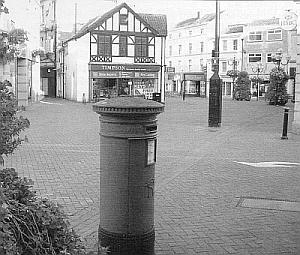 The first box No.1 was in the Channel Islands in 1852 in Union Street, St Peter Port and is still in use today. The oldest post box in daily use today on the British mainland is at Barnes Cross in Dorset. Both of these are hexagonal pillar boxes.
The first box No.1 was in the Channel Islands in 1852 in Union Street, St Peter Port and is still in use today. The oldest post box in daily use today on the British mainland is at Barnes Cross in Dorset. Both of these are hexagonal pillar boxes.
We have tried to list all the boxes in Trowbridge. We are quite lucky to have a large Victorian box outside W.H. Smith dated around 1889 and there are at least three Edward VII boxes. One is a wall box opposite Palmer Gardens (the former Islington sub post office) dated around 1901–1910 and sadly is in need of some TLC. There is a large Edward VII pillar box in Wingfield Road and a thinner one in Frome Road. Each monarch has a quite different cipher. Although Edward VIII reigned for only a very short time, post boxes with his cipher were made and of course exist today, our nearest ones are in Bristol. We have George V 1910–1936, George VI 1936–1952 and the present Queen Elizabeth from 1952.
There are many different sizes of pillar boxes, wall boxes and lamp boxes fixed on posts of different shapes and sizes, and now we also have boxes in supermarkets and garages. Royal Mail do move these boxes at times &ndash there was 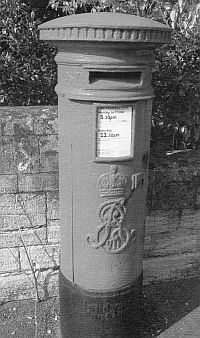 a pillar box outside the Texaco garage in Bythesea Road which they just took away when it was damaged! Boxes also get stolen as they fetch quite big money. Around and about, Bath has two very interesting boxes in Pulteney Street, both hexagonal like the very old ones. Beanacre (in the layby near the church) has a Nigerian box. This does not have fluting on the rim and, as the name suggests, was originally made for Nigeria. There is also one the same at Avebury. There is a Post Office Museum in Bath at the corner of Green Street and Broad Street next to the main post office and also private collections throughout the country that are open to the public. A very good one on the Isle of Wight is well worth a visit for anyone on holiday there.
a pillar box outside the Texaco garage in Bythesea Road which they just took away when it was damaged! Boxes also get stolen as they fetch quite big money. Around and about, Bath has two very interesting boxes in Pulteney Street, both hexagonal like the very old ones. Beanacre (in the layby near the church) has a Nigerian box. This does not have fluting on the rim and, as the name suggests, was originally made for Nigeria. There is also one the same at Avebury. There is a Post Office Museum in Bath at the corner of Green Street and Broad Street next to the main post office and also private collections throughout the country that are open to the public. A very good one on the Isle of Wight is well worth a visit for anyone on holiday there.
So next time you post a letter just take a moment to took at the box, see how old it is and how it has served us for many years. We should get our ‘special boxes’ in Trowbridge listed as gradually they will disappear just like the red telephone boxes. I hope in future you will find posting a letter a little more interesting! For more information about the Letter Box Study Group go to: www.lbsg.org
A decommissioned Edward VIII pillar box stands in the foyer of the gift shop at Longleat – quite close to the Nazi memorabilia display! Eds
More Trowbridge Street Names
This latest set of Trowbridge Street names is perhaps more obvious. Trowbridge is a classic example of a medieval town plan. When the Normans decided to build a castle in Trowbridge they took no account of the Saxon town layout, and the castle was built across the line of the road/track from the Hilperton ridge to the crossing of the Biss.
Consequently the road had to wind its way around the castle. Castle Street would have led from the Biss to the market place in front of the castle gates. It would have joined the road that curved around the front of the castle, which for that reason was called Fore Street. The houses facing on to Fore Street were built on long narrow pieces of ground called burgage plots, with the land behind being the yard or garden with perhaps outhouses as well. The footpath to the back of these plots ran parallel to Fore Street and obviously became known as Back Street. Up until the 1860s the name Back Street was used for the street stretching from Silver Street to Hill Street. Although the origins of Hill Street look obvious from its upward course, in fact the name comes from the Old English healh meaning a sheltered place. There are several curious passageways off Fore Street. Narrow Wine Street was formerly known as Cottle's Barton, the courtyard or yard in front of a house owned by a family of clothiers called Cottle. Some bartons became passages between two major roads, in the case of Cottle's Barton between Castle Street and Fore Street, but only part of the original course remains. Why it was subsequently called Narrow Wine Street is unknown, a nickname for a short cut to the public house? Red Hat Lane was named after a former 18th century inn on the site. White Hart Yard is named after the White Hart Inn. Both pubs are shown in Ken Rogers' “The Book of Trowbridge”.
Silver Street is more of a puzzle – many towns have such a street. It may be have been so called on account of silversmiths residing there, or more likely is that using a name associated with wealth and prosperity was an example of early PR to encourage trade in the town! Roundstone Street continues from Silver Street, all part of what is arguably the oldest road in Trowbridge. The Round Stone which once stood at the corner of Roundstone Street and Polebarn Road was a noted landmark. It was removed in the early 1700s and never returned. Roundstone Street had numerous earlier names. According to Bodman the original name was Eastgate Street, the use of the suffix gate usually indicates an entrance to the town or city. However Ken Rogers has never seen that name used on any document. Lovemead Street is recorded in 1462. Latterly in the nineteenth century it was called Mead Street and apparently at one time it was the site of a hamlet called Lovemead. Polebarn Road was originally the site of Paul's Barn – on the 1860 Trowbridge map it is shown as Polebarn Lane. In 1692 a group of houses in a poor state in Back Street, known locally as Rotten Row, were demolished and a new development, Duke Street, was carried out on behalf of the lord of the manor, Charles Seymour, 6th Duke of Somerset. Duke Street named after him, was then a cul–de–sac; it was not until relatively recently that access through to The Halve was made. Off Duke Street is a small enclosure of houses named Silverthorne Barton. However the name actually belongs to the cut–through between Duke Street and Roundstone Street next to the Wiltshire Times offices. The enclosure of the common fields had left one narrow strip isolated, which was described in 1752 as “the half at the town’s end”. When building began on the strip in 1784 the street was initially called Paradise Row, but the older name of The Halve prevailed.
Welcome to the following new members
Mr & Mrs D Birks; Mr & Mrs C Blakeley; Miss V Cole; Mr & Mrs J Constable; Mr C Forsythe; Mr & Mrs C Muller; Miss J Teasdale.
Book Review
Trowbridge is full of picturesque reminders of its cloth–making heritage but those who wish to discover the booming, grimy reality of the town in the early 19th Century should not miss The Diary of William Henry Tucker, edited by Helen Rogers and recently published by the Wiltshire Record Society. The diarist started work in a clothier’s counting-house in 1827 at the age of 13 and rose to become a successful travelling salesman for J. T. Stancomb at Cradle Bridge Mill before setting up his own business; he died in Frome in 1877, a prosperous businessman.
We learn of the smoke and dust in which Trowbridge was enveloped in his youth and “the stench” of the factory where he worked – “the shaking occasioned by the machinery and the unwholesome heat”. There are occasional mentions of industrial unrest and frequent references to funerals and illness – after a bad bout of typhus he meets the men who had been “preparing for the task of carrying me to my grave” but, despite all this, the general tone of the book is one of vigour and enjoyment of life. “What shall I do with all these girls?” he asks after the birth of his third daughter but he is a proud and interested parent. He is a keen cricketer and in 1832 he attends the Trowbridge Reform Festival with its “donkey racing, pig hunting, greasy pole climbing and other intellectual amusements”. He is a great traveller – often on foot, but even before the railway arrived at Trowbridge the transport facilities open to him are surprisingly developed; on a business trip in August 1847, for example, he takes the afternoon boat to Bath and thence by rail to Birmingham via Bristol and Gloucester; over the next two days he returns through Worcester, Cheltenham, Gloucester, Stroud and Swindon before taking “a pleasant ride home” from Chippenham “in Little's van”. There are many outings to escape from the smoke of Trowbridge, walking for miles in the countryside, bathing in the river or canal, skating in winter, picnicking on the way to Longleat, “cowslipping” at Rood Ashton and boating at Orchardleigh (the great estates seemed remarkably open).
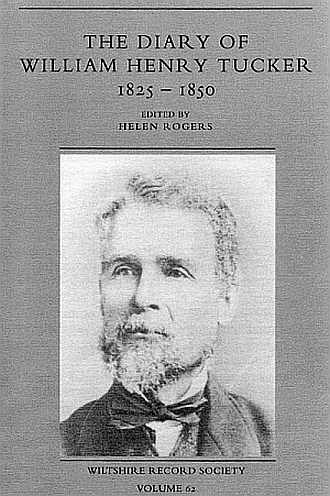 Despite leaving school at 13 he was a great reader and an amusing, if often caustic, writer, with the outspokenness of the pre–Victorian age even when commenting on leading citizens of Trowbridge or the entertaining qualities of the many religious services he attended. One Sunday in September 1835, he and a companion (probably his wife–to–be) walked to Holt church in the morning (“secreting our provisions in the hedge”), ate their lunch at the Bell at Broughton Gifford – “where I ordered two and a half pints of strong beer and twopence worth of bread with some quantum of cheese”, before continuing to Broughton church – “a most barbarous place and a most contemptible parson, unfit for anything but a scarecrow, and the music of the choir was certainly excelled in point of melody by the geese that cackled on the common”. They then walked home “through storms and sunshine” to hear Mr Eacott preach at the Bethel chapel in the evening!
Despite leaving school at 13 he was a great reader and an amusing, if often caustic, writer, with the outspokenness of the pre–Victorian age even when commenting on leading citizens of Trowbridge or the entertaining qualities of the many religious services he attended. One Sunday in September 1835, he and a companion (probably his wife–to–be) walked to Holt church in the morning (“secreting our provisions in the hedge”), ate their lunch at the Bell at Broughton Gifford – “where I ordered two and a half pints of strong beer and twopence worth of bread with some quantum of cheese”, before continuing to Broughton church – “a most barbarous place and a most contemptible parson, unfit for anything but a scarecrow, and the music of the choir was certainly excelled in point of melody by the geese that cackled on the common”. They then walked home “through storms and sunshine” to hear Mr Eacott preach at the Bethel chapel in the evening!
William Tucker was an informative and entertaining man and Helen Rogers provides maps, photographs, and an excellent introduction putting his life and diary in its historical context.
The Diary of William Henry Tucker 1825 – 1850:
Wiltshire Record Society, £20.
ISBN 9780901333384.
Now available from Trowbridge Museum shop. Ed
Trowbridge Market Charter
Earlier this year the Civic Society ordered a copy of the Trowbridge Market Charter from the National Archives. We are grateful to Ken Rogers for his work in typing the Latin so that it can be read and then translating it into English. (See below) Ken also provided the notes and a picture of the great seal of King John. In due course the Society will have a copy mounted and framed to present to the Town Council. The Trowbridge Market Charter of 1st March 1200 is 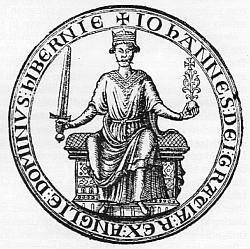 only known to us from the ‘office copy’ kept on the Charter Roll in the Royal Chancery, and still forming part of the national archives. A copy sealed with the king's great seal would have been issued to Henry de Bohun to keep among his records to prove his right to hold the market and fair. This has not survived.
only known to us from the ‘office copy’ kept on the Charter Roll in the Royal Chancery, and still forming part of the national archives. A copy sealed with the king's great seal would have been issued to Henry de Bohun to keep among his records to prove his right to hold the market and fair. This has not survived.
“John by the grace of God King of England etc. Know that we have given and granted and by this present charter confirmed to Henry de Bohun that he may have a market for one day in each week, namely on Tuesday, at Troubrig, and that he may have a fair there lasting for three days, namely on the vigil of St James the Apostle before August, and on St James's day, and on the morrow of the same feast of St James, unless it be to the damage of neighbouring markets and fairs. Wherefore we wish and firmly order that the said Henry and his heirs after him may have and hold well and in peace the said market and fair with all liberties and free customs belonging to such a market and fair unless it be to the damage of neighbouring markets and fairs.
Witnesses William Marshal, Earl of Pembroke, Robert de Turnham, William Brewer, Hugh Bardolf, William de Kantilup. Given by the hands of S. Archdeacon of wells and John de Gray of Winchester, the first of March in the first year of our reign.”
N.B. The etc. in the first line stands for John's other titles as Lord of Ireland, Duke of Normandy and Aquitaine, and Count of Anjou, which would have been given in full in Henry's copy.
More (or less) on Milestones
Prompted by Norman Rogers’ article in the last issue I have discovered the location of a few more. Modern 0S 1:25000 maps simply mark milestones as “MS” but older series give that and include the inscriptions. Hence West  Ashton: “Melksham 6, Westbury 3” on the Yarnbrook road opposite the cottages, metal plate missing. “Melksham 5, Westbury 4” on the Semington road near Amouracre farm, not found but may be in brook. Hilperton: “Trowbridge 2, Devizes 8” near (Upper) Paxcroft Farm, octagonal plate missing. Widbrook: “Def”, i.e. defaced, 100 metres before Widbrook bridge, not found. Yarnbrook: “Trowbridge 3, Westbury 2”, on the Westbury road, unfortunately the replacement plate has those two distances but also the fanciful addition of “99 London”. Between West Ashton and Semington: “Melksham 4, Westbury 5” near the Great Hinton road junction, not found.
Ashton: “Melksham 6, Westbury 3” on the Yarnbrook road opposite the cottages, metal plate missing. “Melksham 5, Westbury 4” on the Semington road near Amouracre farm, not found but may be in brook. Hilperton: “Trowbridge 2, Devizes 8” near (Upper) Paxcroft Farm, octagonal plate missing. Widbrook: “Def”, i.e. defaced, 100 metres before Widbrook bridge, not found. Yarnbrook: “Trowbridge 3, Westbury 2”, on the Westbury road, unfortunately the replacement plate has those two distances but also the fanciful addition of “99 London”. Between West Ashton and Semington: “Melksham 4, Westbury 5” near the Great Hinton road junction, not found.
Incidentally I have noticed that between Devizes and Marlborough there are hardly any gaps in the nicely carved stones one every mile.
There is a British Isles Milestone Society and the Wiltshire co–ordinator for this is the Wiltshire Archaeological and Natural History Society, based at Devizes museum.
Textile Garden
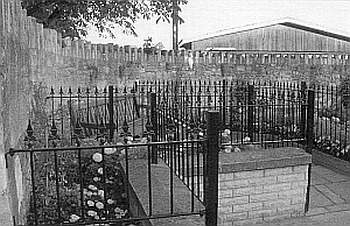 Since 1998 the Civic Society has been leasing from St James's Church the small garden next to the Church Hall, which we planted with appropriate plants to illustrate those used in the textile industry. Our present chairman Glyn Bridges, at that time mayor of Trowbridge, officially opened it on 30th April 1999. However volunteers to help maintain it were sadly very scarce. During the past few years we have paid for upkeep and have had help from The Shaw Trust. Last year's mayor John Knight named the Amber Foundation as his charity and in recognition of this the charity offered to look after the garden with the active support of the town council. St James's Church subsequently gave the society notice and the Amber Foundation have transformed the garden by landscaping it and putting
in iron railings and a delightful seating area. They assure us that the textile theme will be carried on.
Since 1998 the Civic Society has been leasing from St James's Church the small garden next to the Church Hall, which we planted with appropriate plants to illustrate those used in the textile industry. Our present chairman Glyn Bridges, at that time mayor of Trowbridge, officially opened it on 30th April 1999. However volunteers to help maintain it were sadly very scarce. During the past few years we have paid for upkeep and have had help from The Shaw Trust. Last year's mayor John Knight named the Amber Foundation as his charity and in recognition of this the charity offered to look after the garden with the active support of the town council. St James's Church subsequently gave the society notice and the Amber Foundation have transformed the garden by landscaping it and putting
in iron railings and a delightful seating area. They assure us that the textile theme will be carried on.
Heritage Open Day in Trowbridge 2009
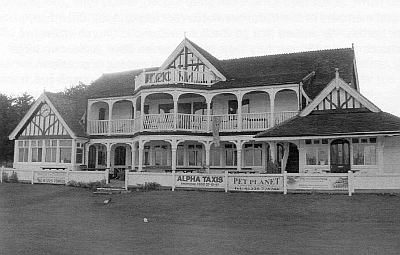 This year was the busiest so far with 11 events and openings spread over all four days. Thanks are due to the Museum staff, especially Alex, who helped to link the temporary exhibition on Textiles and Weaving with HODs. Ken Rogers gave an excellent lecture on the Somerset and Wiltshire woollen industry. Although much of what he said is already in print in one or more of his books, I felt that I understood it much better having listened to him. Ivan Clark, the Museum weaver, demonstrated the Dobcross Loom, and Ken led a Weaving Walk. Roy Berrett spoke about the last days in the last mill to close.
This year was the busiest so far with 11 events and openings spread over all four days. Thanks are due to the Museum staff, especially Alex, who helped to link the temporary exhibition on Textiles and Weaving with HODs. Ken Rogers gave an excellent lecture on the Somerset and Wiltshire woollen industry. Although much of what he said is already in print in one or more of his books, I felt that I understood it much better having listened to him. Ivan Clark, the Museum weaver, demonstrated the Dobcross Loom, and Ken led a Weaving Walk. Roy Berrett spoke about the last days in the last mill to close.
The Blind House was very popular with 175 visitors (25 more than last year). Several people have told me since that they missed it but will definitely visit next September. Sadly fewer people ventured out of the town centre to visit Holy Trinity Church, St Thomas's Church, Zion Chapel and the County Cricket Club Pavilion. Twenty peope braved the spiral staircase to visit St James's Church Bell Tower, all saying what a wonderful experience it was.
Pevsner
Often quoted in our Newsletter but what is it? Professor Sir Nikolaus Pevsner was a wonderful man who toured Britain making an inventory of interesting and important buildings in our towns and villages. His work has been continued and revised by others and now the whole of the British Isles is covered county by county.
Do you get your pilasters muddled with your pediments? Do you struggle to think of something to ask for a Christmas present? Of course you do so why not ask for Pevsner's Wiltshire guide published by Yale ISBN 0 300 09659 3. It's not cheap (about £20, but 2nd hand copies are available through sites like Amazon and Bookbarn) but it's crammed with information and taking it in the car or rucksack makes journeys so much more interesting. Trowbridge merits 11 closely typed pages and Southwick (our previous abode) lists 6 significant buildings. If you need another gift why not ask for Somerset too (two volumes though)?
CORPORATE MEMBERS: – Coleman’s Family Dental Practice, Timbrell Street |
RECENT MEETINGS |
Coffee Morning
 Where did we go this time on Saturday 13th June? We were invited by John and Kay Austin to their home, 46 St Thomas's Road, Trowbridge. A bright and sunny morning encouraged a goodly number to attend and enjoy John and Kay's beautiful garden and also the excellent coffee and cakes. To add interest there was a very full stall of bring and buy goods which was manned by good neighbours (voluntarily after mentioning that they would like to join the society).
Where did we go this time on Saturday 13th June? We were invited by John and Kay Austin to their home, 46 St Thomas's Road, Trowbridge. A bright and sunny morning encouraged a goodly number to attend and enjoy John and Kay's beautiful garden and also the excellent coffee and cakes. To add interest there was a very full stall of bring and buy goods which was manned by good neighbours (voluntarily after mentioning that they would like to join the society).
Mention must also be made of the raffle, which was well supported by prizes donated and tickets purchased. Finally John was willing to share the fruits of his labours and sold lovely home grown lettuce very much cheaper than any Supermarket in town. Once again many thanks to John and Kay for a most enjoyable morning.
Midsomer Norton visit 20th May 2009
Our group was greeted at the Town Hall by several members of the Midsomer Norton Society and the Chairman, Paul Meyer, who gave a presentation on Midsomer Norton. We walked first to the Roman Catholic Church where we were given a short talk by the local priest. The church is in a 15th century tithe barn of seven bays. It has two large 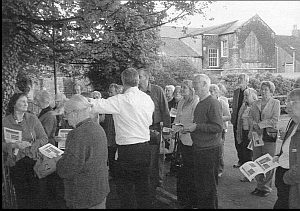 porches to the north and south making it cruciform. There is also a fine timber roof. Over the south porch is a room which was originally accommodation for the granger. From here we walked to the Parish Church where the vicar told us about the history of the church. Here, the tower is 17th century and the rest of the church is 1830 with some later additions. Possibly the most curious thing is a statue of Charles II in a niche on the south side of the tower. Another short walk took us to an area called The Island where we saw some interesting Georgian houses and then a short walk down the High Street before returning to the Town Hall where we were shown some of the work the Norton group were doing to record oral histories. This was followed by refreshments after which we were presented with a framed picture of Midsomer Norton. The whole evening was quite delightful and our very warm welcome by so many of the host group made it especially so. We Look forward to returning their hospitality when they visit us on 20th May 2010 for a guided tour of Trowbridge followed by refreshments.
porches to the north and south making it cruciform. There is also a fine timber roof. Over the south porch is a room which was originally accommodation for the granger. From here we walked to the Parish Church where the vicar told us about the history of the church. Here, the tower is 17th century and the rest of the church is 1830 with some later additions. Possibly the most curious thing is a statue of Charles II in a niche on the south side of the tower. Another short walk took us to an area called The Island where we saw some interesting Georgian houses and then a short walk down the High Street before returning to the Town Hall where we were shown some of the work the Norton group were doing to record oral histories. This was followed by refreshments after which we were presented with a framed picture of Midsomer Norton. The whole evening was quite delightful and our very warm welcome by so many of the host group made it especially so. We Look forward to returning their hospitality when they visit us on 20th May 2010 for a guided tour of Trowbridge followed by refreshments.
An evening in Medieval Devizes 14th July 2009
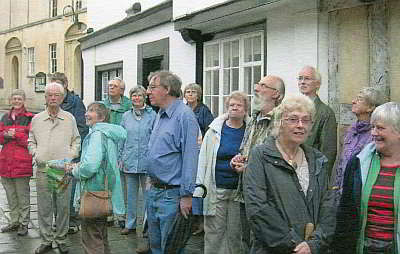 The overcast damp evening of 14th July paled into oblivion with John Girvan, alias a 12th Century Man at Arms, complete with helmet, skull cap, doublet, shirt of coarse fibres and broadsword, when he led 20 members of the Civic Society on a fascinating trail through medieval Devizes, or ‘Castrum Ad Divisas’, which means ‘Castle at the Divide’ of the Manors (of Cannings, Potterne and Rowde). His Lively interpretation of Devizes' history ensured a captive audience.
The overcast damp evening of 14th July paled into oblivion with John Girvan, alias a 12th Century Man at Arms, complete with helmet, skull cap, doublet, shirt of coarse fibres and broadsword, when he led 20 members of the Civic Society on a fascinating trail through medieval Devizes, or ‘Castrum Ad Divisas’, which means ‘Castle at the Divide’ of the Manors (of Cannings, Potterne and Rowde). His Lively interpretation of Devizes' history ensured a captive audience.
We started from the Market Cross which bears an inscription to ‘Ruth Pierce’ from Potterne, who with three other ladies in 1725 had agreed to pay an equal share for a sack of corn. When asked for her contribution, Ruth Pierce protested her innocence by saying ‘may God strike me dead if I’ve told a lie’. Dying instantly, her unpaid share was found in her hand!
Across the ‘trackway’ with its 21st century ‘mechanical perambulators’, to the Bear Hotel, once a coaching inn, then bypassing another timber framed building dating back to 1559, we reached Castle Lane, the original castle approach. The first castle built of wood with a motte and bailey in 1086 was burned down in 1113. Bishop Roger of Sarum in 1120 rebuilt a much bigger stone castle, with three drawbridges and five portcullises. Destroyed in the 17th century, it was rebuilt by a clothier between 1840 and 1860 in the Neo Norman style. It is now privately owned.
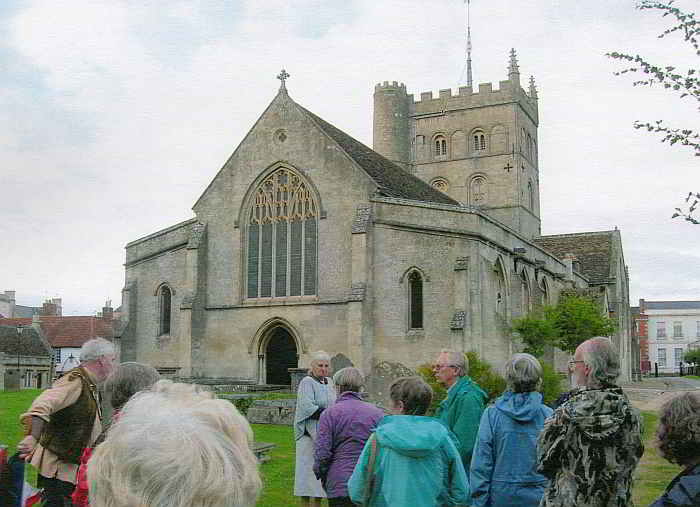
On the death of Henry 1st his daughter Matilda and her cousin Stephen (her father's nephew), each proclaimed the throne. The Devizes people supported Matilda who did succeed but was never crowned. Walt plaques on the Abbey National building commemorate Bishop Roger and Matilda.
Devizes town, laid out by Bishop Roger on his castle's eastern outskirts, is in a crescent shape to link the north gate (now Wadworth's Brewery) and south gate (now the Southgate Pub).
St John's Alley with its overhanging timber framed buildings built around 1550, and its central open ground drain for sewage, was a tanner market where leather goods were made and sold.
Norman in origin, St John's was built within the castle's inner bailey as the garrison church. Its rectangular tower is believed to be unique. The larger more ornate windows were put in later by the Tudors.
Overhanging timber framed buildings, some of which have herring boned brick work line St John's Court. Number 4, with its intact internal barrel roof is the oldest building in Devizes dating back to the 1450's.
Originally timber framed, Devizes Town Hall stood on legs until 1806, when Thomas Baldwin reconstructed the front in stone. Used initially for the wool and food markets, it is still known as the ‘Cheese Hall’.
Long Street, the main street through the fortified town was known for its timber framed buildings and frontages. Many of these were re–fronted in Georgian times, but the amount of stone used was dependent on what the owners could afford, with poorer people using more brick than stone. When developers were stripping the building now occupied by ‘Dorothy House’ they discovered its earlier timber framed structure, dated 1563. Located at the front of Old Swan Yard it could have been a coaching inn, providing stabling, livery and accommodation for horsemen.
Brittox, meaning fortified way to the castle's inner bailey, comes from the Norman French bretasche. Monday Market Street, another medieval market, with Tudor gabled buildings stands on the outer bailey. Devizes' second oldest building is here (circa 1450). Privately owned, this property too retains its original inner hall with carved beams. In New Park Street, the recently refurbished buildings reflect the Longstones Textile Factory of 1785, and in Snuff Street the original factory office structure of the John Anstey Tobacco Factory has also been retained.
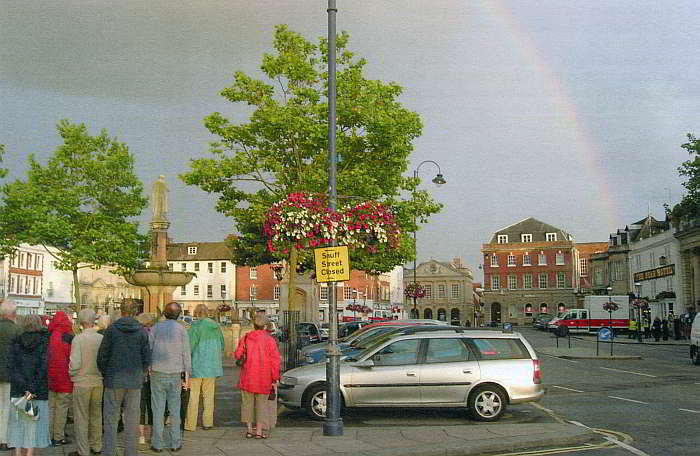
Members pause to admire the rainbow over Devizes Market Place during their visit on 14th July
Bring and Buy at the HOPE NATURE CENTRE 15th August 2009
Despite reasonable weather customers were in rather short supply and we took less money than last year, sharing just over £40 with the Hope Nature Centre at Southwick Country Park. Nevertheless it was a great pleasure to see some constant supporters, and the quality of the goods on offer was magnificent. Kay and I are very pleased with our purchase of the bamboo wind chimes – not sure what the neighbours make of them though. Unfortunately the rather stiff wind somewhat damaged the society's gazebo &ndash but it is still usable as those visiting the Blind House on Heritage Open Day will testify.
Castel Coch, Caerphilly and Cardiff Castles 19th August 2009
You can see the fairy tale conical roofs of Castle Coch as you approach from the motorway. This is a Gothic fantasy created by the architect William Burgess for the Marquess of Bute between 1875 and 1891. The castle is built on the remains of a small 13th century fortress in the beech woods of Fforest Fawr so the plan of the castle is quite accurate but the rest, as it says in the guide book, is “a dazzling tour de force of the high Victorian era, a romanticized and dream-like castle which combines sumptuous Gothic fantasy with timeless fairy tale”. You cannot fail to be impressed by the sheer quality of the craftsmanship and the materials used.
From Castel Coch we took the short drive to Caerphilly Castle. This is an enormous 13th century castle surrounded by moats and lakes. The castle fell out of use after the Civil War until the later part of the 18th century when the first Marquess of Bute began preservation work. Three generations of Marquesses recorded the details of the castle, cleared structures built against its walls as leases ended and eventually undertook painstaking analysis and restoration of the fallen masonry. The greater part of reconstruction was undertaken in the 1930's. –Today it sits well beside the small town of Caerphilly.
It took about half an hour to drive to Cardiff Castle. Here we saw another of William Burgess's creations, of equal quality with Castle Coch but on a far greater scale. The castle not only has splendid state rooms in a grand mansion, designed by Burgess, but it is built on the foundations of a Roman fort in the middle of which is an enormous twelve sided Norman keep on a very high motte. There is a link with Trowbridge in that one of the architects who worked with Burgess on both castles was William Frame who was born in Trowbridge. It could be that the heating system was installed by Haden's as the grilles looked familiar but I have not been able to verify this yet. The splendid interiors of both castles give an idea of what our own Town Hall could look like if it is ever restored.
Over 30 members of the society enjoyed a really great day out.
©Trowbridge Civic Society 2009
